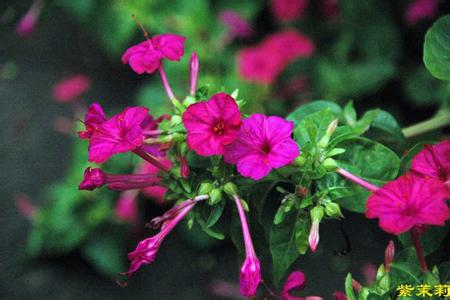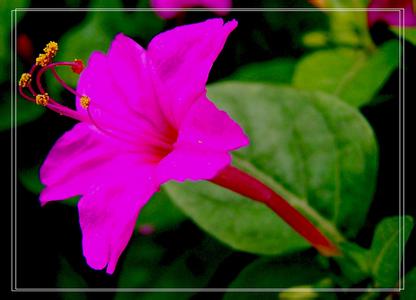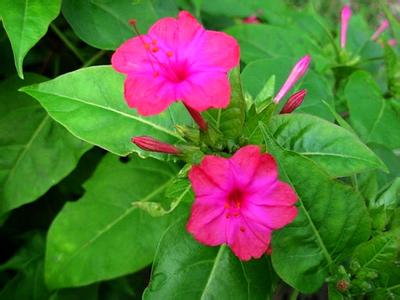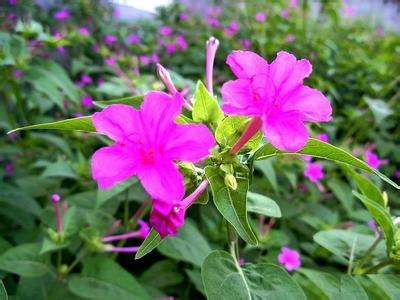Introduction to the language of purple jasmine
The common name of purple jasmine is rouge flower, also known as wild jasmine. In fact, purple jasmine does not look like jasmine at all, but it has a faint fragrance of jasmine, and the word "wild" deserves it-because if you throw a few seeds into the soil, purple jasmine will grow a large clump of vitality and expand its field year after year.

Purple jasmine language: chastity, simplicity, exquisite, conjecture, suspicion, mature beauty, timidity, cowardice
Introduction of purple jasmine
Purple jasmine is named for its purple-red flowers, but it is rich in colors, such as red, yellow, white and variety. when it blossoms in summer, a plant is covered with purple jasmine flowers of many different colors, which is very lovely and beautiful. Purple jasmine flowers are delicate and beautiful, pleasant fragrance, often planted in flower beds, roadside for ornamental use, can also be made into bonsai to watch at home.
Purple jasmine grows healthily and is easy to survive. And it has the property of resistance to sulfur dioxide, so it can be planted in residential balconies or industrial and mining polluted areas. In family farming, if you can wash meat and fish water and wash rice water from time to time, the flowers will bloom more vigorously and the flowers will be more colorful.
Rouge flowers are not only fragrant, but also have cosmetic, heat-clearing and detoxifying effects on their seeds and leaves. When the seeds mature, the appearance is black like a ball, and the inside is white. When cosmetology, you can take a number of mature seeds, grind them into powder, remove powder and rub your face after peeling, and remove facial spots to make your face smooth, white and cosmetic.
In addition, when there are blisters on the hand, you can also take powder and water and apply it evenly to the affected area to remove dampness and detoxification. When skin trauma or carbuncle sore, take several pieces of fresh leaves of rouge flowers, smash and apply to the affected area.

The origin of the flower name:
1. Purple jasmine. It gets its name because of its purplish red flowers and fragrant jasmine.
2. Evening incense. Purple jasmine flowers bloom in the evening, pleasant fragrance, in some places in the north, also known as "night incense".
3. Rouge flowers. According to legend, Chang'e accidentally knocked over the rouge box while rushing to the moon, and rouge was scattered all over the world, giving rise to gorgeous purple jasmine flowers. Moreover, in the past, women liked to take off the flowers of purple jasmine and press them to extract juice and apply them to their lips to make rouge, so the purple jasmine is also called rouge.
4. Cooking flowers and bath flowers. Purple jasmine blossoms at dusk when rural women light a fire to cook and bathe children, so it is called cooking flower or bath flower. It is said that the cooking flower was caused by a playful child who lost his way in the dark. It wants to tell the children who linger in the wild that when they see the cooking flowers blooming, it means that the sky is about to get dark. My mother has already started cooking and must hurry home to take a bath and eat.
5. Thunder flowers. Purple jasmine fruit oval, black, surface striped folds, shaped like a small mine, so it is also called "Thunder Flower".
6. Powdered flowers. The seeds of purple jasmine are rich in white endosperm, which turns into white powder after drying, which can be used to apply to the face, so it is also known as powdered flowers.

Morphological features:
The main stem of purple jasmine is erect, high 50~100cm, with inflated nodes, much branched and spreading. Leaves opposite, ovate or ovate-triangular, long 3~15cm, broadly 2~9cm, apex acuminate, base truncate or cordate, entire, both surfaces glabrous, veins raised; petiole 1-4 cm long, upper leaves almost sessile. Flowers often fascicled with branch ends, only 1 flower in involucral bract, apetalous, style long 1~2mm, calyx petal-shaped, trumpet-shaped, about 2.5cm in diam., 5-lobed. Lobes triangular-ovate, apex acuminate, glabrous, veined, persistent when fruiting; perianth purplish red, yellow, white or variegated (white, yellow, red are its varieties). Tall feet dish-shaped, tube long 2~6cm, eaves 2.5 inch 3 cm in diameter 5-lobed; flowers open after noon, with fragrance. Withered before noon the next day; stamens 5, filaments slender, often protruding outside flowers, anthers globose; style solitary, linear, protruding outside flowers. Stigma capitate. Corolla funnelform, margin undulate and lobed, but not divided. Achenes are globose, 5~8mm in diameter, leathery, black, longitudinally angled and reticulate, similar to minefield, so purple jasmine is also called minefield. The seeds are white and the cotyledons are very fine powdery.

Function value:
1. Ornamental value. Purple jasmine is rich in flowers and colors, blooming luxuriantly, blooming at night, blooming day and night, blooming fragrant and highly ornamental, so it is suitable to be arranged in cool places in the evening or at night. It can be planted in front and back of the house, next to the hedge, by the side of the road, or cultivated in pieces around the edge of the forest. The perennial characteristics of tuber roots can also be used as stump-like rooting potted plants. Rouge flowers grow healthily and are easy to survive. Moreover, purple jasmine is resistant to sulfur dioxide, so it can be planted in residential balconies or industrial and mining polluted areas.
2. Medicinal value. Purple jasmine is not only fragrant, but its seeds and leaves also have the effects of beauty, heat-clearing and detoxification. When the seeds mature, the appearance is black like a ball, and the inside is white. When cosmetology, you can take a number of mature seeds, grind them into powder, remove powder and rub your face after peeling, and remove facial spots to make your face smooth, white and cosmetic. In addition, when there are blisters on the hand, you can also take powder and water and apply it evenly to the affected area to remove dampness and detoxification. When the skin wound or carbuncle sore, take a few fresh leaves of purple jasmine, mash and apply to the affected area. Flowers spit out a strong aroma at night, which can anaesthetize and dispel mosquitoes.

Growth habits:
Nature likes mild and humid climatic conditions, is not cold-resistant, and the aboveground parts die in winter. The underground parts in the south of the Yangtze River can safely survive the winter and become perennial grass flowers, and new plants will continue to grow in spring next year. Open-field cultivation requires deep, loose and fertile loam, and pot cultivation can use general flower culture soil. It grows better in slightly shaded places. Flowers open in the evening to early morning, close in strong light, grow and blossom well in summer with sparse shade, and defoliation often occurs in the scorching sun. Like good ventilation and good environment.
It's very easy to survive. Moreover, purple jasmine is resistant to sulfur dioxide, so it can be planted in residential balconies or industrial and mining polluted areas.
2. Medicinal value. Purple jasmine is not only fragrant, but its seeds and leaves also have the effects of beauty, heat-clearing and detoxification. When the seeds mature, the appearance is black like a ball, and the inside is white. When cosmetology, you can take a number of mature seeds, grind them into powder, remove powder and rub your face after peeling, and remove facial spots to make your face smooth, white and cosmetic. In addition, when there are blisters on the hand, you can also take powder and water and apply it evenly to the affected area to remove dampness and detoxification. When the skin wound or carbuncle sore, take a few fresh leaves of purple jasmine, mash and apply to the affected area. Flowers spit out a strong aroma at night, which can anaesthetize and dispel mosquitoes.

Growth habits:
Nature likes mild and humid climatic conditions, is not cold-resistant, and the aboveground parts die in winter. The underground parts in the south of the Yangtze River can safely survive the winter and become perennial grass flowers, and new plants will continue to grow in spring next year. Open-field cultivation requires deep, loose and fertile loam, and pot cultivation can use general flower culture soil. It grows better in slightly shaded places. Flowers open in the evening to early morning, close in strong light, grow and blossom well in summer with sparse shade, and defoliation often occurs in the scorching sun. Like good ventilation and good environment.
Related
- Wuhan Hospital Iron Tree Blooming Result Was Instantly Frightened by the Gardener Master
- Which variety of camellia is the most fragrant and best? Which one do you like best?
- What is the small blue coat, the breeding methods and matters needing attention of the succulent plant
- Dormancy time and maintenance management of succulent plants during dormancy
- Minas succulent how to raise, Minas succulent plant pictures
- What are the varieties of winter succulent plants
- How to raise succulent plants in twelve rolls? let's take a look at some experience of breeding twelve rolls.
- Attention should be paid to water control for succulent plants during dormant period (winter and summer)
- Watering experience of twelve rolls of succulent plants
- Techniques for fertilizing succulent plants. An article will let you know how to fertilize succulent plants.



